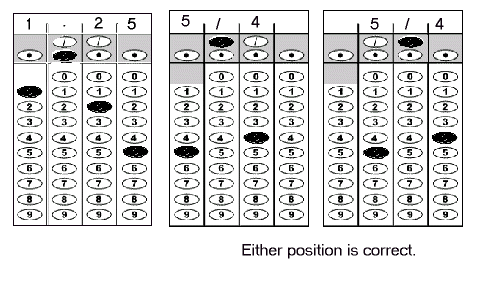 |
| Home | Teacher | Parents | Glossary | About Us | |||||||||||
|
|
|||||||||||
|
SAT Grid-Ins
Information provided by www.kaptest.com
Student-Produced Response questions, or Grid-ins, is a question type that simulates a more natural math test-taking experience by offering questions outside the multiple-choice format. On Grid-ins, you're supposed to come up with your own response. The catch is that you have to fill your answer into a funny-looking grid. There are 10 Grid-ins on the quantitative section of the SAT, so Grid-Ins account for one-sixth of your quantitative score. The math tested on Grid-ins is the same as that tested on Regular Math questions: junior and senior high school level arithmetic, algebra and geometry.
To answer a Grid-in question, you must fill out a grid with four boxes and a column of ovals beneath each. It's recommended that you first write your numerical answer in the boxes above and then shade in the corresponding ovals below. You must fill out the grid properly to get credit for a correct answer. So take some time to learn the directions for Grid-ins.
Directions: For each of the following questions, solve the problem and indicate your answer by darkening the ovals on the special grid. For example: If the correct answer is 1 1/4, then grid-in the number as 1.25 or 5/4, like so:
Grid in the result
- It is recommended, through not required, that you write your answer in the boxes at the top of the columns. However, you will receive credit only for darkening in ovals correctly.
- Grid only one answer to a question, even though some problems may have more than one correct answer.
- Darken no more than one oval per column.
- No answers are negative.
- Mixed numbers cannot be gridded. For example: the number
must be gridded as 1.25 or 5/4 (if it is gridded as 11/4, it will be interpreted as
, not
).
- Decimal accuracy: Decimal answers must be
entered as accurately as possible. For example,
if you obtain an answer such as 0.1666. . ., you
should record the result as .166 or .167. Less
accurate values such as .16 or .17 are not acceptable.Acceptable ways to grid

1 / 6 .166 .167
What all this means to you:
- Your answer must have at most 4 characters, including the decimal point or fraction bar.
- The grid cannot accommodate negative numbers, mixed numbers, or numbers greater than 9,999.
- A fractional number with 4 digits won't fit.
- Mixed numbers must be changed to decimals or fractions before you grid.
- Decimals must be as complete as possible (for long or repeating decimals, use as many columns as possible) but do not have to be rounded up for accuracy's sake.
- Many questions may have more than one correct answer, and there may be many ways to fill in the grid correctly (just choose a single safe one).
- You will only get credit for filling in the ovals correctly—if you fill in two ovals in the same column, the computer reads this as an omission.
SAT Grid-Ins - Sample Question #1
For the following sample questions, you will not have to fill your answer into a grid, but you will have to type in a response that could constitute a correct Grid-in answer.

